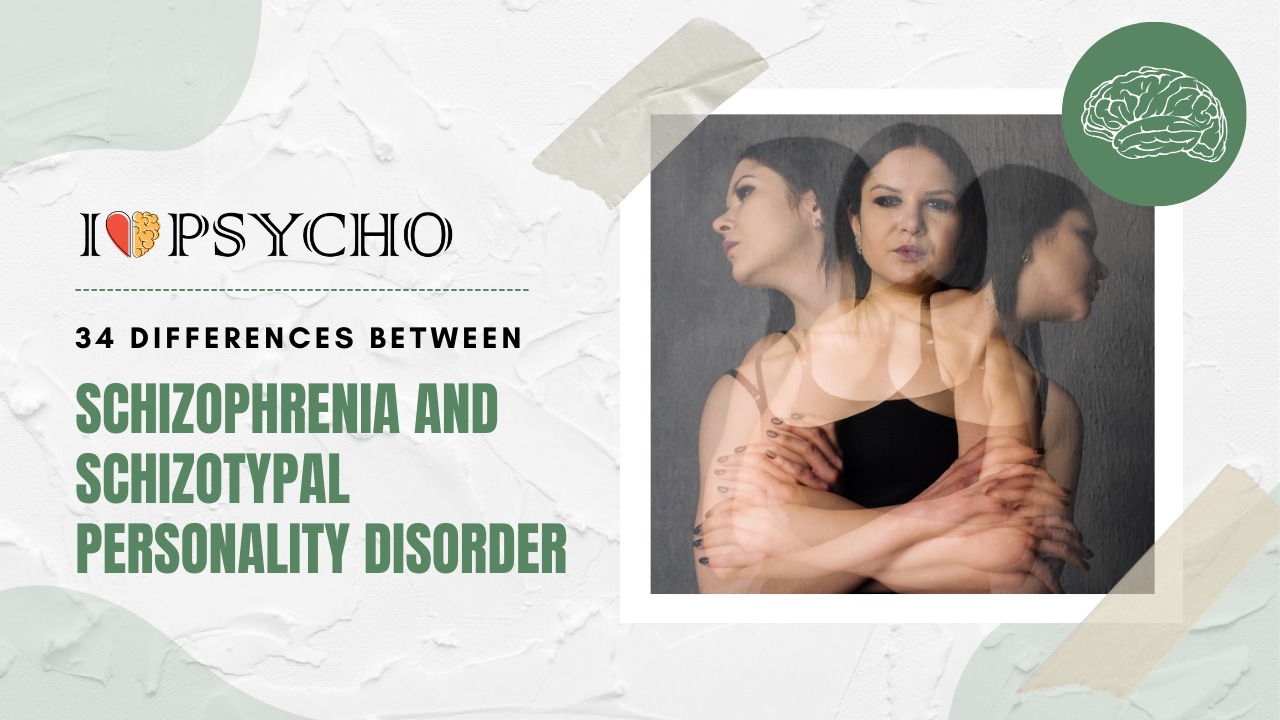Schizophrenia and Schizotypal Personality Disorder (STPD) have comparable symptoms and traits but differ in diagnosis criteria, length, and impact on persons’ lives. Schizophrenia is a severe, persistent mental condition that affects thoughts, emotions, and behavior. It usually causes hallucinations, delusions, disordered thinking, aberrant motor activity, and negative symptoms including decreased emotional expressiveness or avolition. Schizophrenia symptoms last at least six months and impair daily functioning.
Schizotypal Personality condition, a personality condition, is characterized by social and interpersonal deficiencies, cognitive or perceptual abnormalities, and eccentric conduct. STPD can cause strange ideas, magical thinking, unexpected perceptual experiences, and paranoia, like schizophrenia. These symptoms are frequently milder than schizophrenia, and STPD patients often understand reality. STPD symptoms usually start in late adolescence or early adulthood and persist, making it hard to build strong connections and operate socially.
The degree of disability distinguishes the two illnesses. Schizophrenia can affect vocational, intellectual, and social functioning, requiring hospitalization or rigorous therapy. Schizotypal Personality Disorder sufferers may have social difficulties and unhappiness, although their functioning may be less affected.
Another distinction is symptom duration and stability. Acute symptom aggravation and remission define schizophrenia, although some impairment endures between episodes. Schizotypal Personality Disorder has more consistent and chronic symptoms.
Schizophrenia and Schizotypal Personality Disorder have similar symptoms but differing diagnosis criteria, levels of impairment, and life consequences. A severe and persistent psychotic condition, schizophrenia causes cognitive, emotional, and behavioral abnormalities that can limit functioning. Instead, Schizotypal Personality Disorder is characterized by erratic behavior, cognitive abnormalities, and difficulty developing deep connections, but with less severe symptoms than schizophrenia. A skilled mental health practitioner must diagnose these problems accurately to provide individualized therapy and support.
Also Read: 30 Difference between Narcissistic Personality Disorder (NPD) and Avoidant Personality Disorder
Here are 34 differences between Schizophrenia and Schizotypal Personality Disorder:
|
S.No. |
Aspects |
Schizophrenia |
Schizotypal Personality Disorder |
|
1 |
Diagnostic Category |
Schizophrenia is a psychotic disorder characterized by disturbances in thought, emotion, and behavior. |
Schizotypal Personality Disorder is a personality disorder characterized by eccentric behavior and distorted thinking. |
|
2 |
Nature of Disorder |
Schizophrenia is considered a severe mental illness. |
Schizotypal Personality Disorder is a personality disorder and typically less severe than schizophrenia. |
|
3 |
Onset |
Schizophrenia usually manifests in late adolescence or early adulthood. |
Schizotypal Personality Disorder typically has an earlier onset, often in late adolescence or early adulthood. |
|
4 |
Core Symptoms |
Core symptoms of schizophrenia include hallucinations, delusions, disorganized thinking, and impaired social functioning. |
Core symptoms of schizotypal personality disorder include odd beliefs, eccentric behavior, and difficulty with close relationships. |
|
5 |
Duration of Symptoms |
Schizophrenia symptoms are typically continuous or episodic, lasting for at least six months. |
Schizotypal Personality Disorder symptoms are more stable and enduring over time. |
|
6 |
Reality Testing |
Individuals with schizophrenia often have impaired reality testing and may not recognize their delusions or hallucinations as false. |
Those with schizotypal personality disorder usually have better reality testing and recognize their eccentric beliefs as unusual. |
|
7 |
Severity of Delusions |
Delusions in schizophrenia are often more severe and bizarre, involving elaborate and false beliefs. |
Delusions in schizotypal personality disorder are typically less severe and may involve odd or eccentric beliefs. |
|
8 |
Impaired Insight |
Impaired insight is common in schizophrenia, with individuals often unaware of their illness. |
Insight is generally better in schizotypal personality disorder, with individuals recognizing their unusual beliefs as peculiar. |
|
9 |
Social Isolation |
Social withdrawal is common in schizophrenia due to the severity of symptoms. |
Social isolation may occur in schizotypal personality disorder, but it’s often related to eccentric behavior rather than psychosis. |
|
10 |
Hallucinations |
Auditory hallucinations are common in schizophrenia. |
Hallucinations are less common in schizotypal personality disorder and, if present, tend to be milder. |
|
11 |
Impaired Functioning |
Schizophrenia often leads to significant impairment in daily functioning, including work and relationships. |
Schizotypal personality disorder may cause impaired functioning but to a lesser extent than schizophrenia. |
|
12 |
Affective Symptoms |
Schizophrenia can involve mood disturbances like depression or mania. |
Schizotypal personality disorder is primarily characterized by eccentric thinking and behavior, not mood disturbances. |
|
13 |
Formal Thought Disorder |
Thought disorder, including disorganized thinking and speech, is common in schizophrenia. |
Thought disorder is less severe in schizotypal personality disorder. |
|
14 |
Medication Response |
Antipsychotic medications are often used to treat schizophrenia. |
Medications may not be as effective for schizotypal personality disorder since it is primarily a personality disorder. |
|
15 |
Genetic Factors |
There is a strong genetic component in schizophrenia. |
Schizotypal personality disorder also has genetic factors but is not as strongly hereditary as schizophrenia. |
|
16 |
Neurological Abnormalities |
Structural brain abnormalities are often observed in schizophrenia. |
Neurological abnormalities are less pronounced in schizotypal personality disorder. |
|
17 |
Substance Abuse |
Individuals with schizophrenia may be more vulnerable to substance abuse. |
Substance abuse may also occur in schizotypal personality disorder but is not as strongly linked. |
|
18 |
Formal Diagnosis |
Schizophrenia is diagnosed as a distinct mental disorder according to diagnostic criteria. |
Schizotypal personality disorder is diagnosed as a personality disorder separate from schizophrenia. |
|
19 |
Disorganized Behavior |
Disorganized behavior is common in schizophrenia, including difficulties in self-care and daily routines. |
Eccentric behavior is a defining feature of schizotypal personality disorder. |
|
20 |
Treatment Focus |
Treatment for schizophrenia often focuses on symptom management and relapse prevention. |
Treatment for schizotypal personality disorder often targets improving social and occupational functioning. |
|
21 |
Hallucination Content |
Hallucinations in schizophrenia can be more diverse and distressing. |
If present, hallucinations in schizotypal personality disorder tend to be less distressing and unusual. |
|
22 |
Paranoid Ideation |
Paranoid delusions are common in schizophrenia. |
Paranoid ideation may occur in schizotypal personality disorder, but it’s not as severe or central to the diagnosis. |
|
23 |
Social Relationships |
Individuals with schizophrenia often have more severe difficulties in establishing and maintaining social relationships. |
Social difficulties in schizotypal personality disorder are primarily due to eccentric behavior. |
|
24 |
Premorbid Functioning |
Schizophrenia often involves a decline in premorbid functioning before the onset of symptoms. |
Schizotypal personality disorder may not necessarily show a significant decline in premorbid functioning. |
|
25 |
Response to Stress |
Schizophrenia symptoms may worsen under stress. |
Schizotypal personality disorder symptoms may remain relatively stable under stress. |
|
26 |
Cognitive Impairment |
Cognitive deficits are common in schizophrenia, affecting memory, attention, and executive functions. |
Cognitive impairment is milder in schizotypal personality disorder. |
|
27 |
Childhood Indicators |
There may be childhood indicators of schizophrenia, such as developmental delays. |
Childhood indicators of schizotypal personality disorder may include eccentric behaviors. |
|
28 |
Duration of Treatment |
Treatment for schizophrenia is often long-term, aiming at symptom management and relapse prevention. |
Treatment for schizotypal personality disorder may also be long-term but focuses on improving social functioning. |
|
29 |
Reaction to Antipsychotics |
Individuals with schizophrenia often show a significant response to antipsychotic medications. |
Schizotypal personality disorder individuals may not respond as dramatically to antipsychotics. |
|
30 |
Preoccupation with Conspiracy Theories |
Schizophrenia can involve preoccupations with complex delusional systems. |
Schizotypal personality disorder may involve eccentric beliefs but not necessarily complex conspiracy theories. |
|
31 |
Suicidal Ideation |
Individuals with schizophrenia are at higher risk of suicidal ideation and attempts. |
Suicidal ideation may occur in schizotypal personality disorder but is typically less frequent and severe. |
|
32 |
Speech Patterns |
Speech patterns in schizophrenia can be disorganized, with thought derailment or incoherence. |
Speech patterns in schizotypal personality disorder may be eccentric but not necessarily disorganized. |
|
33 |
Emotional Expressiveness |
Emotional expressiveness can be blunted or inappropriate in schizophrenia. |
Emotional expressiveness may be eccentric but not necessarily blunted in schizotypal personality disorder. |
|
34 |
Occupational Impairment |
Schizophrenia often leads to significant occupational impairment. |
Schizotypal personality disorder may also lead to occupational impairment but is generally less severe. |
Also Read: 25 Differences between Panic Disorder and Agoraphobia
Frequently Asked Questions (FAQS)
Q.1 How do schizophrenia and STPD are different?
Schizophrenia and STPD are different mental illnesses despite symptom similarities. Hallucinations, delusions, disordered thinking, and negative symptoms describe schizophrenia, a severe and persistent mental condition that often impairs life. STPD, a personality disorder with social deficiencies, cognitive abnormalities, and eccentric conduct, seems less severe and more stable with time.
Q.2 Can STPD lead to schizophrenia?
While STPD and Schizophrenia share symptoms, they are distinct illnesses. STPD does not guarantee Schizophrenia. However, STPD symptoms may develop with time, causing additional mental health issues. STPD sufferers need therapy and help to control their symptoms and avoid complications.
Q.3 How do Schizophrenia's negative symptoms differ from STPD?
Problems with emotional and behavioral functioning are negative signs of schizophrenia. Reduced emotional expressiveness, motivation (avolition), and social retreat are symptoms. In STPD, negative symptoms are less severe and mostly connected to difficulty building intimate connections and expressing emotions. While both conditions have unpleasant symptoms, Schizophrenia is more severe and extensive.
Q.4 How do symptoms start and last in the two disorders?
Schizophrenia generally develops in late adolescence or early adulthood and has phases of aggravation and remission. Some impairment continues between bouts. Instead, STPD symptoms begin in late adolescence or early adulthood and are more persistent and may not have an episodic pattern like Schizophrenia. StPD symptoms might last a lifetime, but they’re usually less severe than schizophrenia’s.
Q.5 Are these illnesses treatable?
Despite differing aims and tactics, Schizophrenia and Schizotypal Personality Disorder can be treated and supported. To control symptoms, enhance functioning, and avoid relapses, schizophrenia requires antipsychotics, psychotherapy, and psychosocial therapies. Cognitive-behavioral treatment can assist STPD patients in improving social skills, regulating cognitive distortions, and reducing symptoms-related discomfort.








